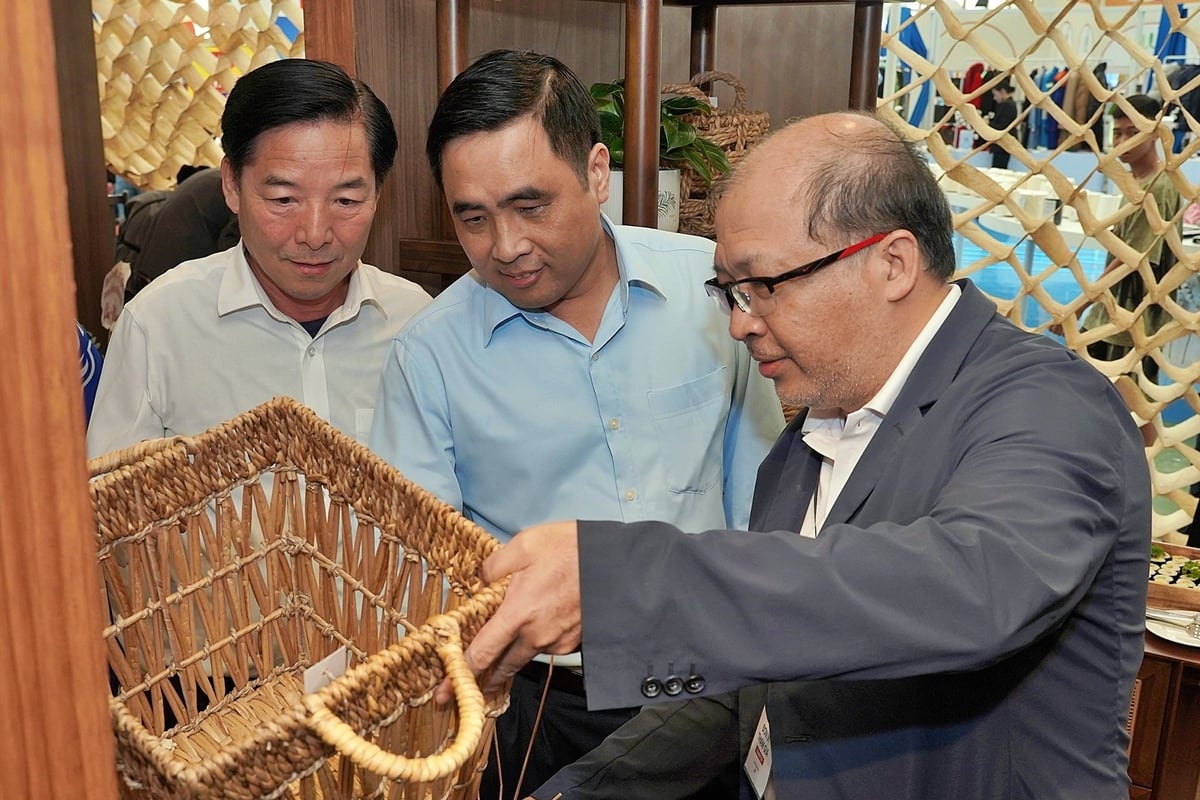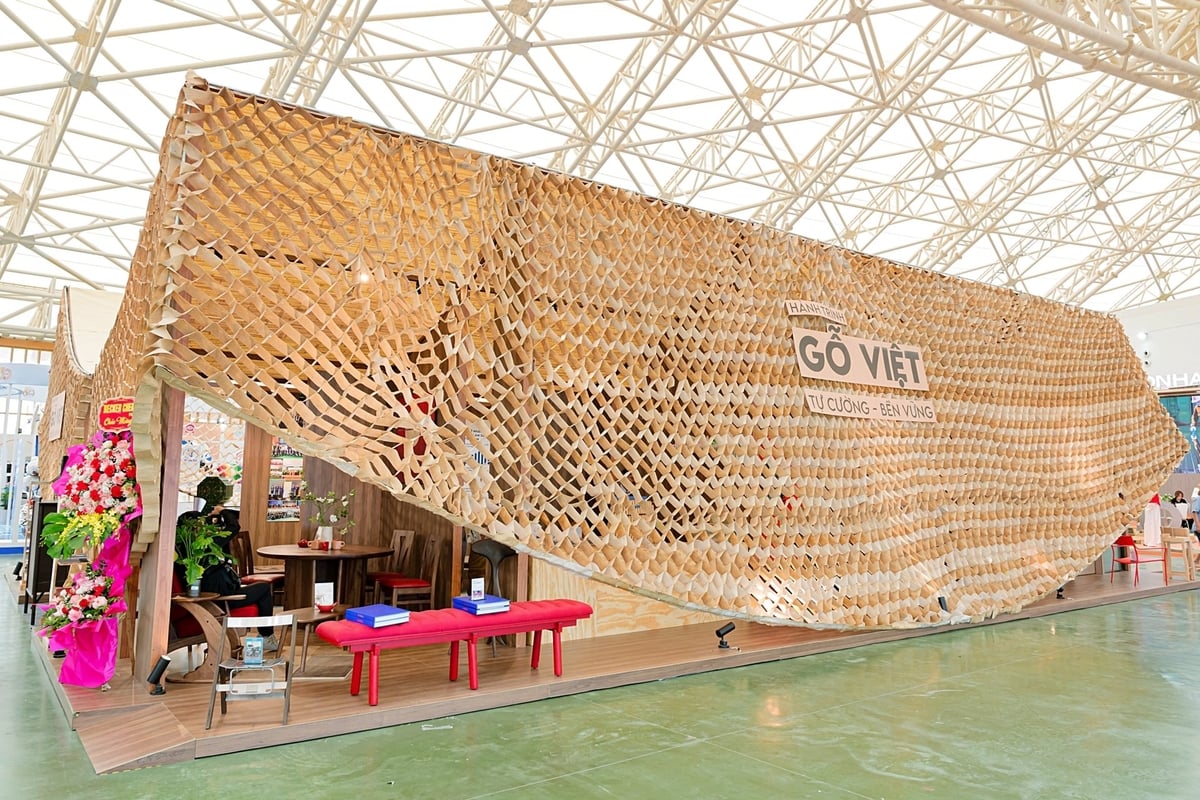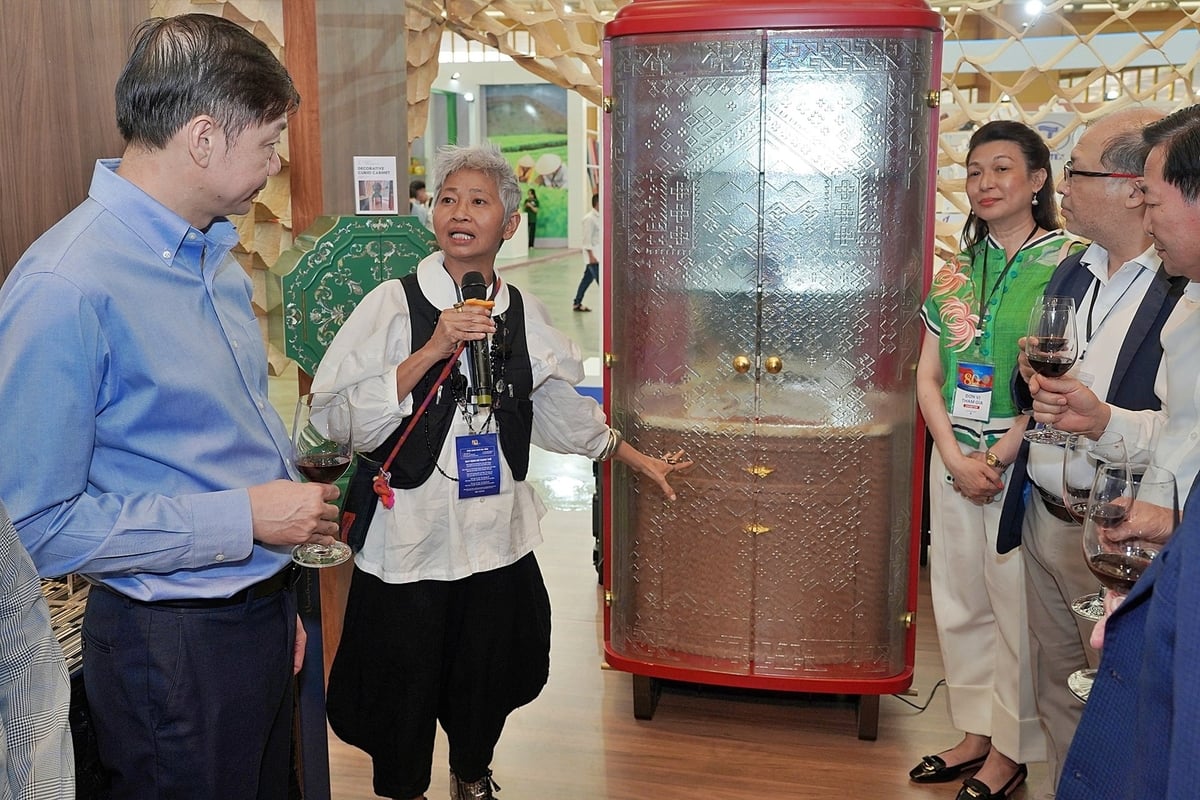December 5, 2025 | 14:27 GMT +7
December 5, 2025 | 14:27 GMT +7
Hotline: 0913.378.918
December 5, 2025 | 14:27 GMT +7
Hotline: 0913.378.918
On the afternoon of August 28, Deputy Minister Nguyen Quoc Tri and a delegation from the Ministry of Agriculture and Environment visited the exhibition space "Vietnam Wood Journey - Resilience and Sustainability".
The National Achievements Exhibition, which opened at the National Exhibition Center in Hanoi in the same morning to commemorate the 80th anniversary of Vietnam's National Day, with the nationwide, intersectoral pavilion as one of its standout features. The Handicraft and Wood Industry Association of Ho Chi Minh City (HAWA) organized the event in collaboration with industry associations and enterprises, under the supervision of the Ministry of Industry and Trade and technical guidance from the Department of Forestry and Forest Protection (MAE).

Deputy Minister of Agriculture and Environment Nguyen Quoc Tri (center) visits handicraft products at the exhibition area. Photo: Bao Thang.
Drawing inspiration from the architecture of the traditional village communal house, which serves as a symbol of unity, the pavilion was designed as a "great communal house" for the wood sector by Atelier Tho. The semi-transparent walls of the space are a testament to the industry's milestones and accomplishments over the course of eight decades, as they incorporate contemporary craft materials, poonah paper of dó paper, and wood. This design evokes for visitirs a sense of both modernity and nostalgia.
Ten smaller displays featured prominent brands, including An Cuong, AA Corporation, Woodsland, Phu Tai, Bao Hung, Minh Duong, Hao Hung, Truong Thanh, and Tan Thanh, beneath this "shared roof". The pavilion also showcased suppliers and innovative start-ups, including Nordic, Snorm, Laita, Minh Long, and Tavico. Each product and narrative collectively depicted the global wood industry of Vietnam's resilience and diversity.
Open free to the public throughout the five-day exhibition, the pavilion served not only as a showcase but also as a hub for trade and networking, offering visitors from home and abroad an immersive visual experience and opportunities for business cooperation.

The exhibition space is inspired by the traditional communal house roof. Photo: Bao Thang.
Deputy Minister of Agriculture and Environment Nguyen Quoc Tri lauded the pavilion's creativity, emphasizing that wood has emerged as one of Vietnam's signature export sectors.
The value of exports in 2000 was a mere USD 219 million. By 2004, it had surpassed USD 1 billion, and it had reached USD 11.3 billion in 2019. Vietnam has become the world's second-largest furniture exporter, following China, as the industry achieved a new record of USD 16.25 billion in 2024, despite the global uncertainties. Currently, the wood sector generates employment opportunities for over half a million individuals and makes a substantial contribution to the gross domestic product in Viet Nam.
Deputy Minister Tri underscored that the pavilion is an affirmation of the sustainable orientation, resilience, and creativity of Vietnam's wood enterprises. MAE leader encouraged wood businesses to prioritize the welfare of forest producers and establish sustainable value chains in addition to pursuing export growth in the future.
This, he said, is the foundation for stable incomes, fair competition among processors, and a stronger international reputation for Vietnamese wood products.

Deputy Minister Nguyen Quoc Tri and Director General Tran Quang Bao present congratulatory flowers. Photo: Bao Thang.
Phung Quoc Man, Chairman of HAWA, also emphasized that future growth will be contingent upon the ability to tell compelling stories, contribute value, and strengthen branding, as the pavilion itself demonstrates. He disclosed that the exhibition display was the outcome of contributions from more than 6,000 enterprises and hundreds of thousands of employees throughout the production chain, from plantation forests to processing plants.

Director General of the Department of Forestry and Forest Rangers, Tran Quang Bao, listens to a presentation about a new product on display at the exhibition. Photo: Bao Thang.
In 25 days, the pavilion will represent a collective achievement, the result of the unwavering commitment of businesses, associations, and organizers. Man characterized it as an image of the Vietnamese timber sector's self-reliance, determination, and creativity. "The business community is greatly motivated by the Ministry's leadership's presence, attention, and encouragement," HAWA chairman stated.
The Department of Forestry and Forest Protection reports that wood and furniture are presently the sixth most significant economic sector in Vietnam and continue to be a prominent sector that demonstrates the country's production, design, and export capabilities.
Translated by Linh Linh

(VAN) As of 2025, the ASEAN region has a total of 69 ASEAN Heritage Parks recognized across its 10 member states. Among them, Viet Nam contributes 15 ASEAN Heritage Parks.

(VAN) Yok Don National Park has high biodiversity with numerous endemic plant and animal species, and it is also the only dipterocarp forest ecosystem conservation area in Viet Nam.

(VAN) Viet Nam and Brunei signed two important MOUs on fisheries and IUU, expanding cooperation in agriculture, the environment, and Halal exports, aiming to substantively implement joint projects.

(VAN) The Viet Nam Coconut Association worked with the International Finance Corporation (IFC) and businesses to promote the supply chain, enhance competitiveness, and develop the coconut industry sustainably.
![Hue aims for Net Zero: [2] Pioneering low-emission tourism](https://t.ex-cdn.com/nongnghiepmoitruong.vn/608w/files/huytd/2025/12/04/0633-dulichzero-4-095634_236-161125.jpg)
(VAN) The ancient capital of Hue has developed Net Zero tourism products and models, aiming to reduce carbon emissions and pioneer the establishment of Viet Nam's green tourism destination.

(VAN) C.P. Viet Nam has announced the successful completion of its goal to plant 1.5 million trees during the 2021-2025 period, a key milestone within company's long-term ESG strategy and its roadmap for emission reduction.

(VAN) This is an initiative of MAE aimed at creating a unified coordination mechanism to implement agricultural cooperation programs with developing countries.